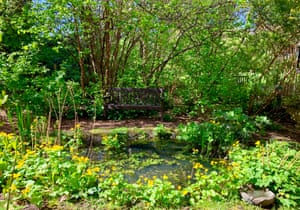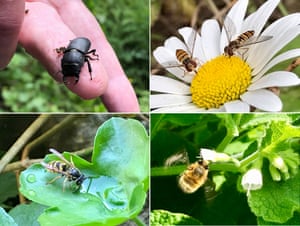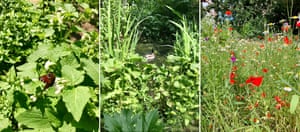“There was literally a frog orgy in that one. There is no other way to describe it,” says Jules Waite, from the London Wildlife Trust, pointing at a pond in the Barbican wildlife garden, one of the few areas of London’s Square Mile whose inhabitants are not in lockdown.
In February, frogs are the first garden residents to feel their passions ignite as they emerge from compost heaps or log piles and slip into the ponds. Self-isolation is the last thing on their mind and by April, the hundreds of tadpoles whizzing around the pond are testament to their efforts. Songbirds are going berserk trying to impress one another and summer visitors such as blackcaps have arrived to set up nest.
In the sky above, London’s top predators – the peregrine falcon, kestrel and sparrow hawk – keep an eye out for pigeons and songbirds flirting in the garden. For less glamorous assassins such as foxes and mallard ducks, spring’s frogspawn is like caviar. All these shenanigans are playing out in a garden a fifth of the size of a football pitch and just half a mile from St Paul’s cathedral.
Q&A What is wild cities week?
Show
Hide
This week, the Guardian’s Age of Extinction site is looking at biodiversity in cities and urban areas around the world, shining a spotlight on the under-appreciated world of nature hidden among the highrises and busy roads.
Around 55% of the world’s population live in urban areas and that number is projected to rise to 68% by 2050. Nature’s role in the wellbeing and happiness of billions of people will be more important than ever. While urbanisation is a major driver of biodiversity loss, many conservationists and town planners are trying to make built-up areas more nature-friendly. The role of green spaces in urban areas has even been formalised in a draft UN agreement to halt and reverse biodiversity loss, often referred to as the Paris agreement for nature.
The Covid-19 outbreak has seen cities and towns across the world go into lockdown which has enabled wildlife such as wild boar, deer, monkeys, foxes and even lions to venture into territory previously dominated by humans. It has also offered us the chance to notice and appreciate the natural world in cities in an unprecedented way.
In this special series of reports we’ll be looking at how animals and plants adapt to city life, what to look out for right now and how we can encourage more wild cities in the future.
This remarkable garden adds a splash of colour to some of the world’s top real estate – it has a miniature meadow, woodland, mature hedges, two ponds and a compost heap – a bucolic scene hidden in the shadow of high-rise living. Less than 50 years ago this patch of land was the rubble of buildings bombed in the Blitz; now it is home to over 450 species, including more than 200 plants and 200 invertebrates.

Most of the Barbican garden’s unusual residents found this spot of their own accord. Stag beetles hitched a ride on old logs brought in from Epping forest. Goldenrod crab spiders – which change colour, turning yellow or white depending on where they are hunting – “ballooned” their way into the garden using little parachutes made from silken threads.
The Barbican’s architecture is famous, but few people know about the wildlife garden. “It’s a secret within a secret,” says Waite. “The Barbican itself and its gardens are a secret – it’s only when you live here you appreciate how peaceful it is. Beyond that you’ve got the wildlife garden, which is even more peaceful, and there are people who live here who don’t even know about it.”

The brutalist Barbican Estate was built by Chamberlin, Powell and Bon between 1965 and 1976. It was designed to be a utopia of urban living, with high density housing, European-style plazas, restaurants, theatres and cinemas. Its striking architecture continues to divide opinion. Everything down to the smallest detail was meticulously designed (even the toilets) – except for one forgotten section at the back of the estate.
Instead of becoming an ornamental garden, this neglected area was made into a basic community garden with a lawn. Money was tight, so the soil was smoothed over the remains of bombed out housing like icing – with one edge dropping 3.5 metres (12ft) lower than the centre. Parts of a cellar still poke through on one side.
In 2003 volunteers decided to turn this unloved area into a nature garden. Once the stage was set, wildlife quickly moved in.

“When I walked around the estate and saw all the planting and then the wildlife garden I almost decided I wanted to live here before seeing a flat. I loved it then as I love it now,” says Jo Rodgers, a Barbican resident who moved in 11 years ago. She leads the team of volunteers with fellow resident Francis Pugh. Before the current lockdown, each Wednesday morning their group spent two hours maintaining the garden.
“It took me some time to realise what wildlife gardening was about. At the beginning I probably went in like a conventional gardener wanting everything neat and tidy. It took me a bit of time to realise that no, we don’t tidy as I did before. We have to protect even the tiniest ladybird.”
Part of the skill of wildlife gardening is to provide sustenance for different species all year round. In February catkins and hawthorn provide nectar for early pollinators. In summer the meadow is covered in cowslips, ox-eye daisies and meadow buttercup (in fact, it looks like many fields would have before the intensification of agriculture). When winter closes in, holly and ivy berries provide valuable energy for birds and small mammals.
Quick guide What does gardening for wildlife mean?
Show
Hide
Forget any assumption that gardening for nature means letting everything go wild. Whether you are managing a couple of acres or a humble window ledge, green spaces need to be managed. To encourage native species of animals and plants, try to provide as many types of habitat that your space will allow, do not use pesticides, plant species that sustain wildlife and include water if you can.
Absolutely. The 430,000 hectares of gardens in the UK are a crucial part of the Wildlife Trusts’ nature recovery network, a plan to rewild the country by connecting habitats in towns, cities and countryside to help nature flourish once again. The RSPB, Wildlife Trusts and the RHS have all produced useful guides on how to garden for nature.
Plastic grass, decking and monoculture lawns, chemical fertilisers and pesticides.
Insects are a crucial part of garden ecosystems but sometimes measures are required to control populations. Instead of using chemical controls, use organic methods and other deterrents where possible. Copper piping and eggshells are useful options to deter slugs and snails. Encouraging larger animals like hedgehogs, frogs and birds that feed on problem insects is also a nature-friendly solution.
Nature dictates how this tiny patch of land is managed. On the south-west side of the garden, where thin soils slope down into the shadows of the surrounding towers, ivy naturally flourished. Volunteers have encouraged it to spread further as it provides food for caterpillars, cover for spiders and nesting sites for birds. The gravel path was built on the regular route a local fox took through the garden.

Each year new species are being enticed into the garden. In 2010 volunteers built a bug hotel made of logs, pallets and bricks to encourage solitary bees, lacewings and ladybirds. The design was based on the low-rise Barbican block, with six floors and a barrel vaulted roof and there are now 14 nest boxes in the garden – seven for house sparrows and seven for blue tits and great tits. Last year’s new arrivals included a black-tailed skimmer dragonfly and house sparrows.
In 2019 the garden won an “outstanding” award in the London in Bloom competition, and more than 700 visitors came for Open Garden Squares Weekend last June. “It’s a real feather in the city’s cap,” says Allison Parkes, a Barbican resident for 15 years who has volunteered in the garden for three years. “People do wildlife experiences abroad and don’t know what’s in their back garden. It’s amazing how nature finds a way and survives in the tiniest of corners. It’s just incredible.”
In lockdown the garden has become even more valuable as a place to sit and watch wildlife flourish under the caress of spring. “Whenever I go, there is always someone trotting around,” says Parkes. “It’s not very often that you go and don’t see someone there. And they might just be sitting on a bench reading the newspaper or peering in a pond. There are always people going in and out.”

As part of a push to protect the garden from being swallowed by the encircling city, volunteers collect weekly data to show how much London’s wildest inhabitants appreciate it. In 2018 volunteers built a bird hide complete with a whiteboard and a little library to help with identification (it looks like something out of a Wes Anderson film). All confirmed species recorded on the site are sent to Green Information for Greater London and the British Trust for Ornithology.
“It’s a historical document in the end; we can’t remember everything, so I think the written word is very important,” says Rodgers. Underneath the garden are the remains of Clarendon printing press, which created the first patented typeface in 1845. Rodgers writes all of the garden’s newsletters in Clarendon font as a nod to the site’s history.
Working in the garden is also a way for residents and others living in the community to get to know each other. Rodgers says: “We’re not gardeners in that sense and we don’t all have to be fit and able to lift great weights of compost. If someone can’t find something to do we do sightings and see what we’ve got. There’s a place for many different sorts of people in the garden.”
Find more age of extinction coverage here, and follow biodiversity reporters Phoebe Weston and Patrick Greenfield on Twitter for all the latest news and features